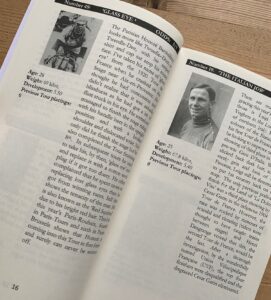- By Ian Chester
- Self published
- Paperback £8.99 (currently £7.52 on Amazon)
- Amazon: https://www.amazon.co.uk/dp/B08BDW3ZSK/
There seems to be increasing interest in the cycle races in France immediately after the First World War. First of all we have Tom Isitt’s excellent Riding in the Zone Rouge: The Tour of the Battlefields 1919 – Cycling’s Toughest-Ever Stage Race [Reviewed HERE] about the ridiculously hard Circuit des Champs de Bataille and now we have Ian Chester telling the tale of the 1919 Tour de France.

And for those of us who enjoy our July (obviously somewhat later in 2020) taken up by the quest for the yellow jersey the tales of these early races are extraordinary.
The author tells the 1919 race’s story with aplomb, providing a detailed breakdown of the riders, their nicknames, palmares and likely odds in the 1919 race. The race has added symbolism; not only was it the first held after the Great War but it was during this edition that the leader started to wear the famous maillot jaune or yellow jersey.

A detailed breakdown of the runners and riders is provided
The history is spot-on and once again the reader is left reeling at the sheer physical endeavour required to complete such an event. The distances involved are staggering – the longest stage was over 450 km and the total race some 5560 km, more than 2000 km than the 2020 addition (3,470 km). The route was also suitably bonkers, starting in Paris but traversing the coastline of France anti-clockwise, taking in the mountains of the Pyrenees and Alps. And to top it all, race organiser Henri Desgrange was the hardest taskmaster, stipulating ultra precise rules. Any breaches were harshly punished. You cannot but feel for the riders as they struggle through the race.
The author lets the story unfold, describing the loss of many of the favourites and the heavy attrition as many riders give up in the first few stages. It is also a journey of discovery as the author covers each stage in his trusty camper van, cycling a number of sections. His knowledge of French and love of the country shines through and many anecdotes are told with a twinkle in his eye.

Each stage has a map of the route
Despite a costly setback whilst down in the French Riviera, Ian eventually completes the Tour route, finding key spots from the 1919 race and honouring them properly. It’s worth noting that the book is self published and whilst I spotted a few typos here and there they certainly do not detract from the overall enjoyment. What is abundantly clear is the author’s fondness and sense of awe for the 1919 racers. I was also interested to read of his grandfather’s part in the First World War and wounding on 15 September 1916 during the Battle of Flers-Courcelette, part of the Battle of the Somme. The stop at Etaples Military Cemetery to visit the grave of his grandfather’s friend was also a nice touch.
For those who enjoy their cycling mixed with a bit of wartime history I highly recommend this book. It’s easy to read, contains plenty of amusing stories (both 1919 and 2019), lots of maps and photographs and has been much enjoyed with a beer in the garden during lockdown.
JB

